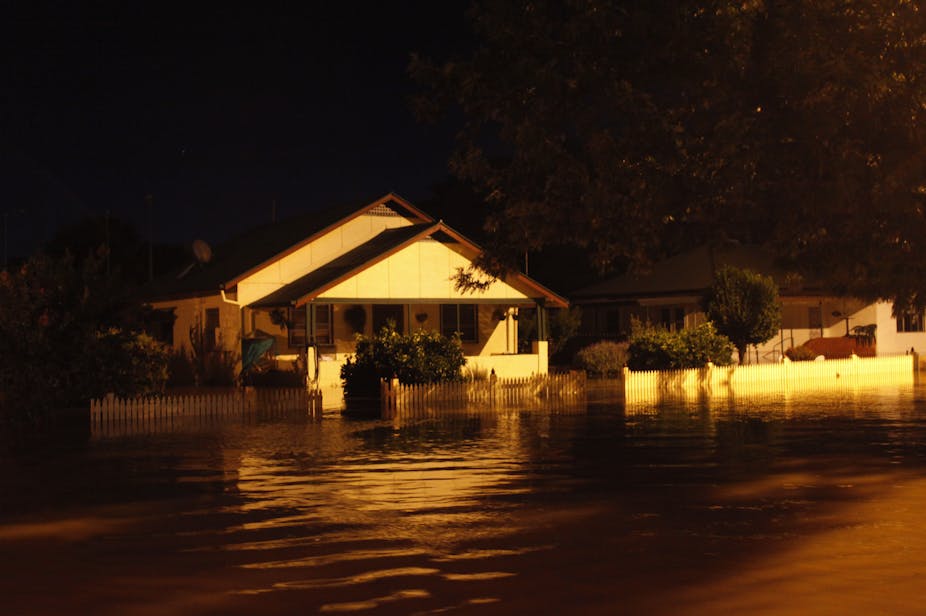The past five years have seen record rainfall and flooding in many towns and cities across eastern Australia. The floods themselves are dangerous, but so are the health hazards associated with the indoor dampness that follows and, more specifically, the excessive mould it encourages.
A lot of indoor mould growth resulted from Hurricane Katrina and the flooding of homes in New Orleans in 2005. Concern for the health of workers involved in the clean-up led the United States Centres for Disease Control and Prevention to advise that “excessive exposure to mould-contaminated materials can cause health effects in susceptible persons regardless of the type of mould or extent of contamination”.
Two major reports by the United States Institute of Medicine (IOM) (from 2000 and 2004) concluded that there was sufficient evidence of an association between mould and upper respiratory tract symptoms, wheezing, coughing and asthma symptoms in sensitised asthmatic individuals.
Although there’s a strong body of evidence linking indoor dampness to asthma attacks, the exact role of moulds has been difficult to determine because it hasn’t been easy to disentangle mould exposures from the many other exposures that occur in damp indoor environments.
Persistent dampness causes building materials to decompose and release volatile organic compounds (VOCs), such as phthalates, which are released from wet vinyl floors. Mould exposure is complex because residents are exposed to both living and dead spores, and to mould fragments as well as mould products, such as allergens, cell wall chemicals, toxins, and microbial VOCs.
The risks these pose to respiratory health depend on the levels of exposure; “the dose makes the poison” is the central tenet of toxicology. In the case of damp houses, the dose is the concentration of airborne spores and fragments of moulds inhaled through personal exposure.

According to the World Health Organisation (WHO), there are currently no government or industry standards for acceptable levels of indoor airborne mould. This is because measuring exposure levels accurately is difficult; the threshold numbers that provoke asthma attacks are likely to vary with the moulds present; and the varying susceptibilities of exposed individuals.
Health risks for asthma depend on allergic sensitisation. When our team conducted a study of the environmental causes of asthma in 1996, we found 38% of our sample of allergic adults had a mould allergy. Most of these people were also sensitive to other allergens, predominantly house dust mite.
Multiple sensitisation makes the contribution of mould allergy to asthma severity difficult to assess. But our study suggested mould-allergic adults had twice the risk of asthma attacks and wheezing, and were also twice as likely to use asthma medication compared with adults with other allergies.
Clinical studies also suggest that mould allergy is associated with more severe asthma, but more research in needed before we can be confident a causal relationship exists.
Even though the effects of moulds on health are not fully understood, the WHO recommends that dampness and mould-related problems be remediated because “they increase the risk of hazardous exposure to microbes and chemicals”. Remediation usually involves removal of mould-damaged building materials and furnishings, and the use of fungicides.
A 2011 Cochrane Review found that remediation marginally reduces asthma-related symptoms, respiratory infections and decreases the need for asthma medication.
Our 2002 randomised controlled trial (see page A33) of 13 mould-allergic adults showed that dehumidification and cleaning of bedroom surfaces with diluted bleach reduced airborne mould levels and was associated with a significant improvement in peak flow measurements.
Although there’s ongoing debate about whether the level of flooding we’ve recently experienced (and still are in some parts of the country) is due to global warming superimposed on natural Australian climate cycles, we are likely to see an increase in flooding and more exposure to moulds in the near future.
The Climate Commission believes rising ocean temperatures, changes in rainfall patterns, and extreme weather events will lead to increased relative humidity and more exposure to airborne allergens, such as pollens and moulds. And the climate paper just released by CSIRO and the Australian Bureau of Meteorology provides further evidence of a continuing warming trend, which means the risk of mould-related respiratory problems will only increase in the future.
Further research may provide better solutions to the problem of mould-related allergies in the future. In the meantime, risks of respiratory problems can be mitigated by controlling relative humidity with improved insulation, heating and ventilation.

